Cyber Security And Challenges Of Industry Research Paper 2022
VerifiedAdded on 2022/09/22
|11
|2494
|30
AI Summary
Contribute Materials
Your contribution can guide someone’s learning journey. Share your
documents today.
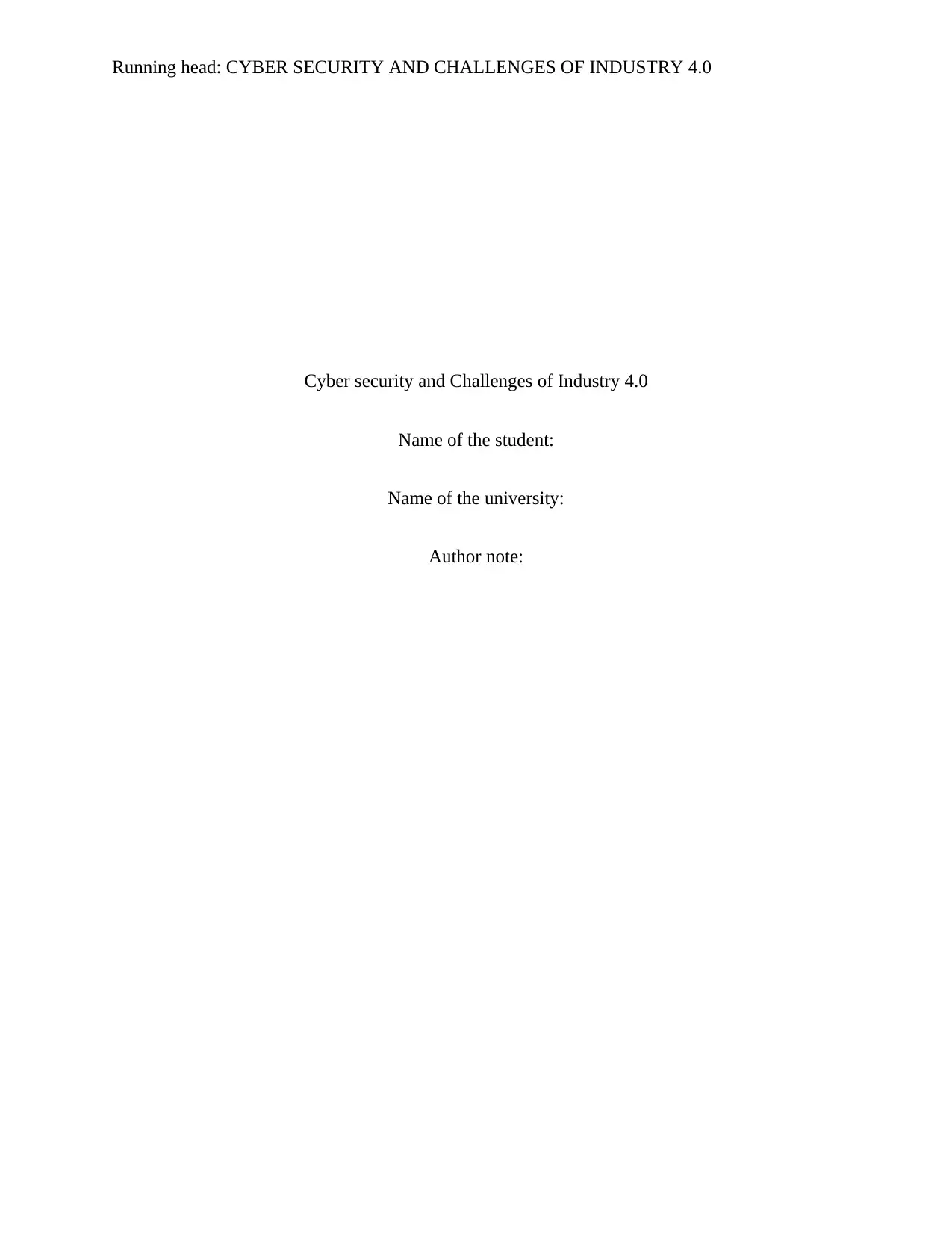
Running head: CYBER SECURITY AND CHALLENGES OF INDUSTRY 4.0
Cyber security and Challenges of Industry 4.0
Name of the student:
Name of the university:
Author note:
Cyber security and Challenges of Industry 4.0
Name of the student:
Name of the university:
Author note:
Secure Best Marks with AI Grader
Need help grading? Try our AI Grader for instant feedback on your assignments.
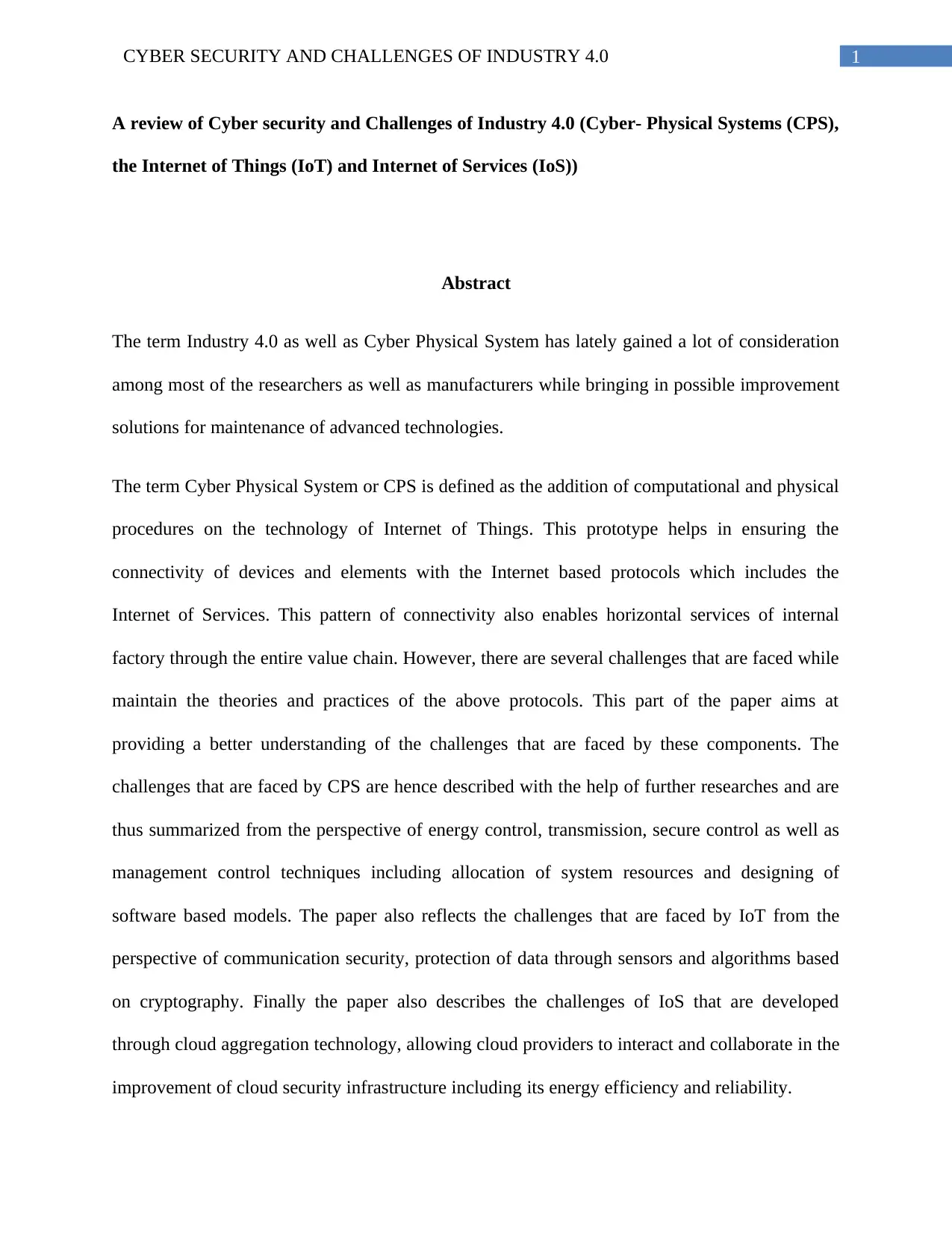
1CYBER SECURITY AND CHALLENGES OF INDUSTRY 4.0
A review of Cyber security and Challenges of Industry 4.0 (Cyber- Physical Systems (CPS),
the Internet of Things (IoT) and Internet of Services (IoS))
Abstract
The term Industry 4.0 as well as Cyber Physical System has lately gained a lot of consideration
among most of the researchers as well as manufacturers while bringing in possible improvement
solutions for maintenance of advanced technologies.
The term Cyber Physical System or CPS is defined as the addition of computational and physical
procedures on the technology of Internet of Things. This prototype helps in ensuring the
connectivity of devices and elements with the Internet based protocols which includes the
Internet of Services. This pattern of connectivity also enables horizontal services of internal
factory through the entire value chain. However, there are several challenges that are faced while
maintain the theories and practices of the above protocols. This part of the paper aims at
providing a better understanding of the challenges that are faced by these components. The
challenges that are faced by CPS are hence described with the help of further researches and are
thus summarized from the perspective of energy control, transmission, secure control as well as
management control techniques including allocation of system resources and designing of
software based models. The paper also reflects the challenges that are faced by IoT from the
perspective of communication security, protection of data through sensors and algorithms based
on cryptography. Finally the paper also describes the challenges of IoS that are developed
through cloud aggregation technology, allowing cloud providers to interact and collaborate in the
improvement of cloud security infrastructure including its energy efficiency and reliability.
A review of Cyber security and Challenges of Industry 4.0 (Cyber- Physical Systems (CPS),
the Internet of Things (IoT) and Internet of Services (IoS))
Abstract
The term Industry 4.0 as well as Cyber Physical System has lately gained a lot of consideration
among most of the researchers as well as manufacturers while bringing in possible improvement
solutions for maintenance of advanced technologies.
The term Cyber Physical System or CPS is defined as the addition of computational and physical
procedures on the technology of Internet of Things. This prototype helps in ensuring the
connectivity of devices and elements with the Internet based protocols which includes the
Internet of Services. This pattern of connectivity also enables horizontal services of internal
factory through the entire value chain. However, there are several challenges that are faced while
maintain the theories and practices of the above protocols. This part of the paper aims at
providing a better understanding of the challenges that are faced by these components. The
challenges that are faced by CPS are hence described with the help of further researches and are
thus summarized from the perspective of energy control, transmission, secure control as well as
management control techniques including allocation of system resources and designing of
software based models. The paper also reflects the challenges that are faced by IoT from the
perspective of communication security, protection of data through sensors and algorithms based
on cryptography. Finally the paper also describes the challenges of IoS that are developed
through cloud aggregation technology, allowing cloud providers to interact and collaborate in the
improvement of cloud security infrastructure including its energy efficiency and reliability.
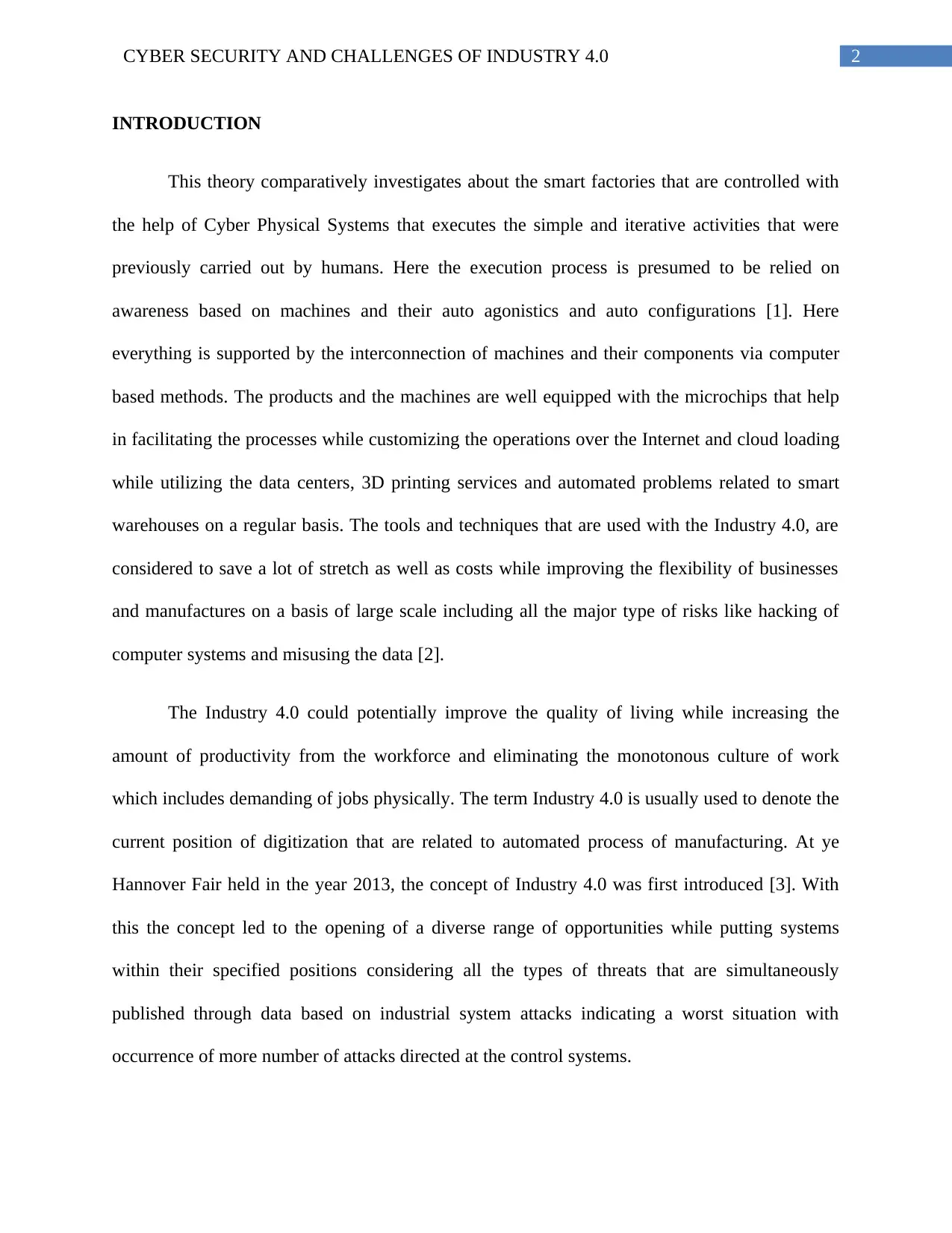
2CYBER SECURITY AND CHALLENGES OF INDUSTRY 4.0
INTRODUCTION
This theory comparatively investigates about the smart factories that are controlled with
the help of Cyber Physical Systems that executes the simple and iterative activities that were
previously carried out by humans. Here the execution process is presumed to be relied on
awareness based on machines and their auto agonistics and auto configurations [1]. Here
everything is supported by the interconnection of machines and their components via computer
based methods. The products and the machines are well equipped with the microchips that help
in facilitating the processes while customizing the operations over the Internet and cloud loading
while utilizing the data centers, 3D printing services and automated problems related to smart
warehouses on a regular basis. The tools and techniques that are used with the Industry 4.0, are
considered to save a lot of stretch as well as costs while improving the flexibility of businesses
and manufactures on a basis of large scale including all the major type of risks like hacking of
computer systems and misusing the data [2].
The Industry 4.0 could potentially improve the quality of living while increasing the
amount of productivity from the workforce and eliminating the monotonous culture of work
which includes demanding of jobs physically. The term Industry 4.0 is usually used to denote the
current position of digitization that are related to automated process of manufacturing. At ye
Hannover Fair held in the year 2013, the concept of Industry 4.0 was first introduced [3]. With
this the concept led to the opening of a diverse range of opportunities while putting systems
within their specified positions considering all the types of threats that are simultaneously
published through data based on industrial system attacks indicating a worst situation with
occurrence of more number of attacks directed at the control systems.
INTRODUCTION
This theory comparatively investigates about the smart factories that are controlled with
the help of Cyber Physical Systems that executes the simple and iterative activities that were
previously carried out by humans. Here the execution process is presumed to be relied on
awareness based on machines and their auto agonistics and auto configurations [1]. Here
everything is supported by the interconnection of machines and their components via computer
based methods. The products and the machines are well equipped with the microchips that help
in facilitating the processes while customizing the operations over the Internet and cloud loading
while utilizing the data centers, 3D printing services and automated problems related to smart
warehouses on a regular basis. The tools and techniques that are used with the Industry 4.0, are
considered to save a lot of stretch as well as costs while improving the flexibility of businesses
and manufactures on a basis of large scale including all the major type of risks like hacking of
computer systems and misusing the data [2].
The Industry 4.0 could potentially improve the quality of living while increasing the
amount of productivity from the workforce and eliminating the monotonous culture of work
which includes demanding of jobs physically. The term Industry 4.0 is usually used to denote the
current position of digitization that are related to automated process of manufacturing. At ye
Hannover Fair held in the year 2013, the concept of Industry 4.0 was first introduced [3]. With
this the concept led to the opening of a diverse range of opportunities while putting systems
within their specified positions considering all the types of threats that are simultaneously
published through data based on industrial system attacks indicating a worst situation with
occurrence of more number of attacks directed at the control systems.
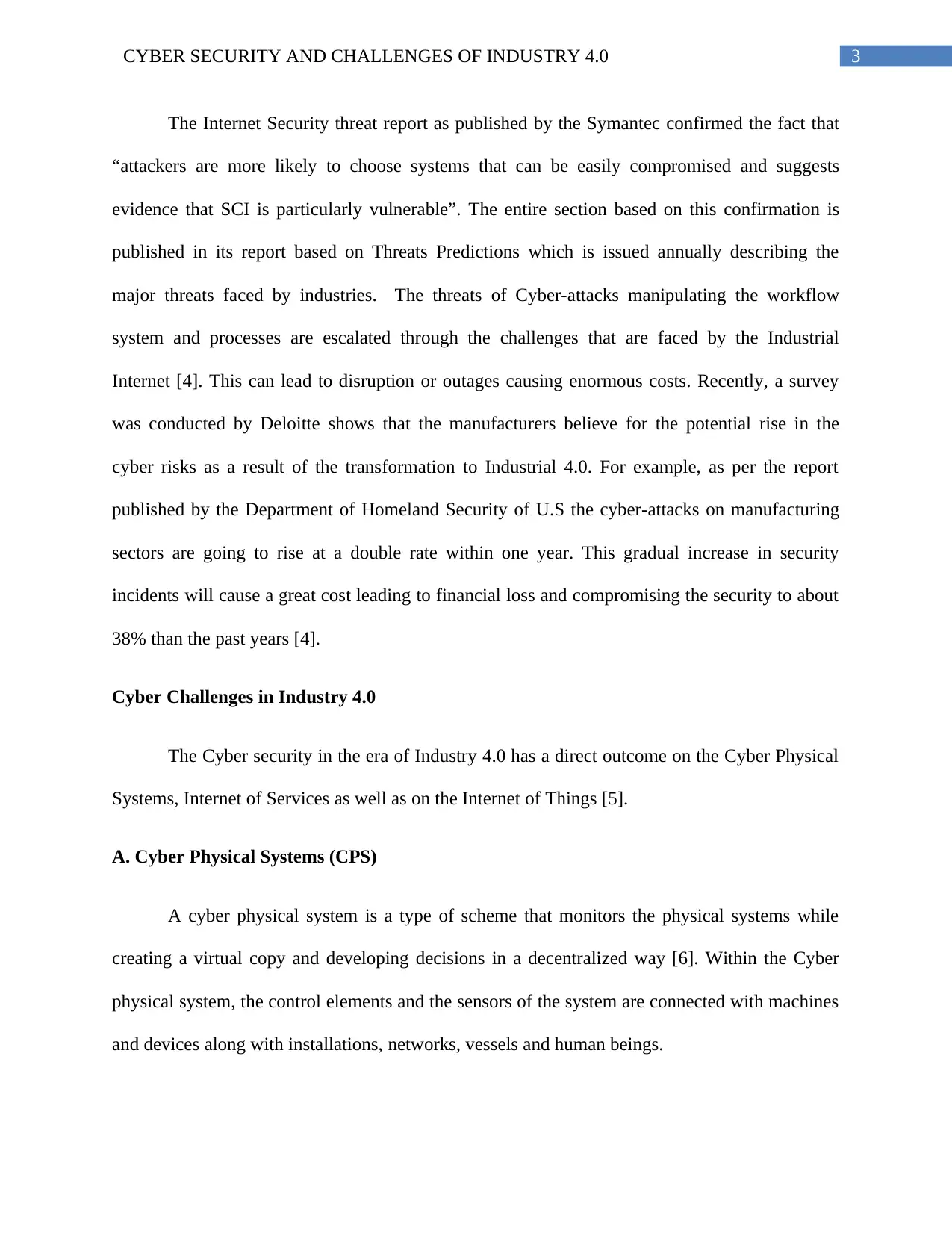
3CYBER SECURITY AND CHALLENGES OF INDUSTRY 4.0
The Internet Security threat report as published by the Symantec confirmed the fact that
“attackers are more likely to choose systems that can be easily compromised and suggests
evidence that SCI is particularly vulnerable”. The entire section based on this confirmation is
published in its report based on Threats Predictions which is issued annually describing the
major threats faced by industries. The threats of Cyber-attacks manipulating the workflow
system and processes are escalated through the challenges that are faced by the Industrial
Internet [4]. This can lead to disruption or outages causing enormous costs. Recently, a survey
was conducted by Deloitte shows that the manufacturers believe for the potential rise in the
cyber risks as a result of the transformation to Industrial 4.0. For example, as per the report
published by the Department of Homeland Security of U.S the cyber-attacks on manufacturing
sectors are going to rise at a double rate within one year. This gradual increase in security
incidents will cause a great cost leading to financial loss and compromising the security to about
38% than the past years [4].
Cyber Challenges in Industry 4.0
The Cyber security in the era of Industry 4.0 has a direct outcome on the Cyber Physical
Systems, Internet of Services as well as on the Internet of Things [5].
A. Cyber Physical Systems (CPS)
A cyber physical system is a type of scheme that monitors the physical systems while
creating a virtual copy and developing decisions in a decentralized way [6]. Within the Cyber
physical system, the control elements and the sensors of the system are connected with machines
and devices along with installations, networks, vessels and human beings.
The Internet Security threat report as published by the Symantec confirmed the fact that
“attackers are more likely to choose systems that can be easily compromised and suggests
evidence that SCI is particularly vulnerable”. The entire section based on this confirmation is
published in its report based on Threats Predictions which is issued annually describing the
major threats faced by industries. The threats of Cyber-attacks manipulating the workflow
system and processes are escalated through the challenges that are faced by the Industrial
Internet [4]. This can lead to disruption or outages causing enormous costs. Recently, a survey
was conducted by Deloitte shows that the manufacturers believe for the potential rise in the
cyber risks as a result of the transformation to Industrial 4.0. For example, as per the report
published by the Department of Homeland Security of U.S the cyber-attacks on manufacturing
sectors are going to rise at a double rate within one year. This gradual increase in security
incidents will cause a great cost leading to financial loss and compromising the security to about
38% than the past years [4].
Cyber Challenges in Industry 4.0
The Cyber security in the era of Industry 4.0 has a direct outcome on the Cyber Physical
Systems, Internet of Services as well as on the Internet of Things [5].
A. Cyber Physical Systems (CPS)
A cyber physical system is a type of scheme that monitors the physical systems while
creating a virtual copy and developing decisions in a decentralized way [6]. Within the Cyber
physical system, the control elements and the sensors of the system are connected with machines
and devices along with installations, networks, vessels and human beings.
Secure Best Marks with AI Grader
Need help grading? Try our AI Grader for instant feedback on your assignments.
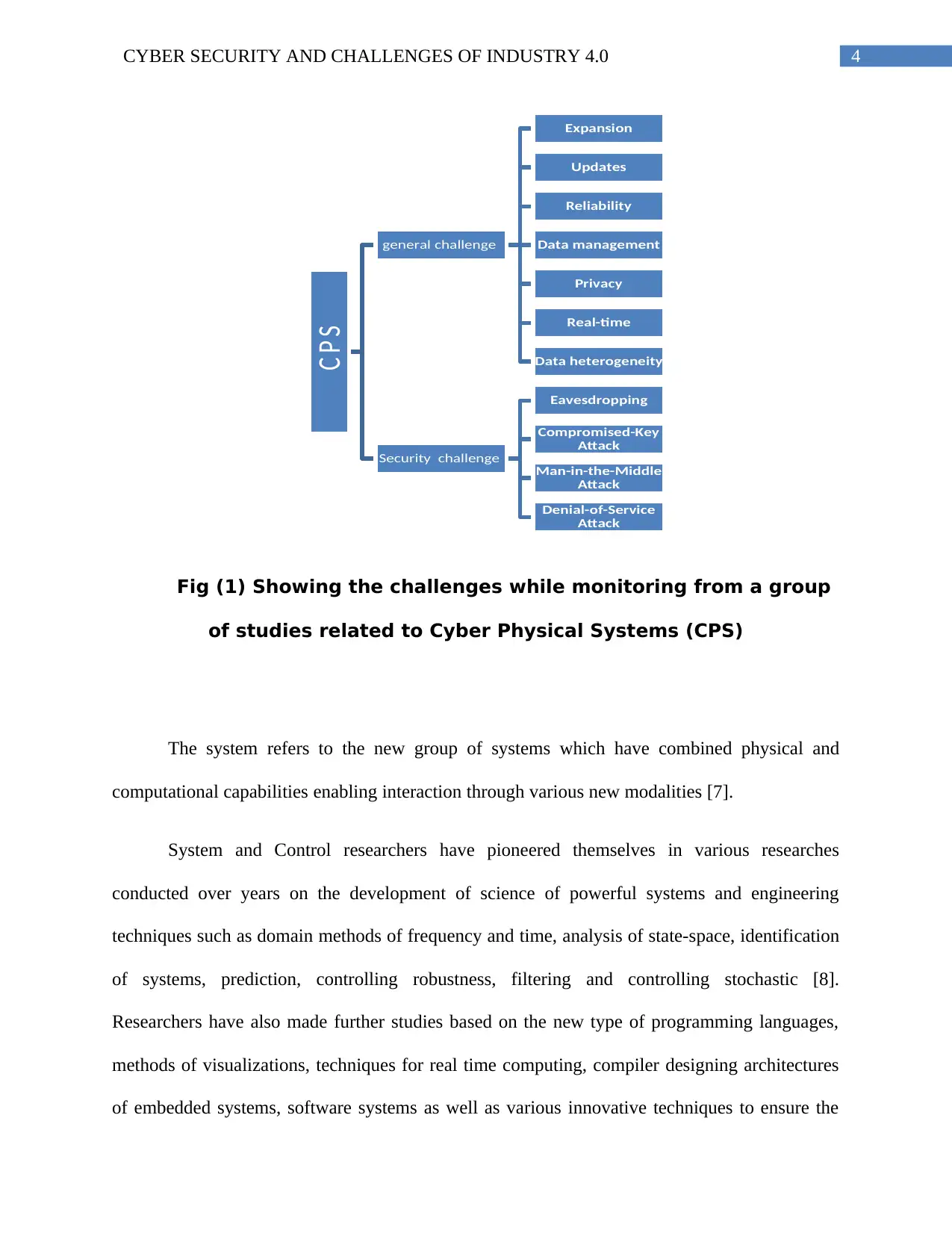
4CYBER SECURITY AND CHALLENGES OF INDUSTRY 4.0
Fig (1) Showing the challenges while monitoring from a group
of studies related to Cyber Physical Systems (CPS)
The system refers to the new group of systems which have combined physical and
computational capabilities enabling interaction through various new modalities [7].
System and Control researchers have pioneered themselves in various researches
conducted over years on the development of science of powerful systems and engineering
techniques such as domain methods of frequency and time, analysis of state-space, identification
of systems, prediction, controlling robustness, filtering and controlling stochastic [8].
Researchers have also made further studies based on the new type of programming languages,
methods of visualizations, techniques for real time computing, compiler designing architectures
of embedded systems, software systems as well as various innovative techniques to ensure the
C P S
general challenge
Expansion
Updates
Reliability
Data management
Privacy
Real-time
Data heterogeneity
Security challenge
Eavesdropping
Compromised-Key
Attack
Man-in-the-Middle
Attack
Denial-of-Service
Attack
Fig (1) Showing the challenges while monitoring from a group
of studies related to Cyber Physical Systems (CPS)
The system refers to the new group of systems which have combined physical and
computational capabilities enabling interaction through various new modalities [7].
System and Control researchers have pioneered themselves in various researches
conducted over years on the development of science of powerful systems and engineering
techniques such as domain methods of frequency and time, analysis of state-space, identification
of systems, prediction, controlling robustness, filtering and controlling stochastic [8].
Researchers have also made further studies based on the new type of programming languages,
methods of visualizations, techniques for real time computing, compiler designing architectures
of embedded systems, software systems as well as various innovative techniques to ensure the
C P S
general challenge
Expansion
Updates
Reliability
Data management
Privacy
Real-time
Data heterogeneity
Security challenge
Eavesdropping
Compromised-Key
Attack
Man-in-the-Middle
Attack
Denial-of-Service
Attack
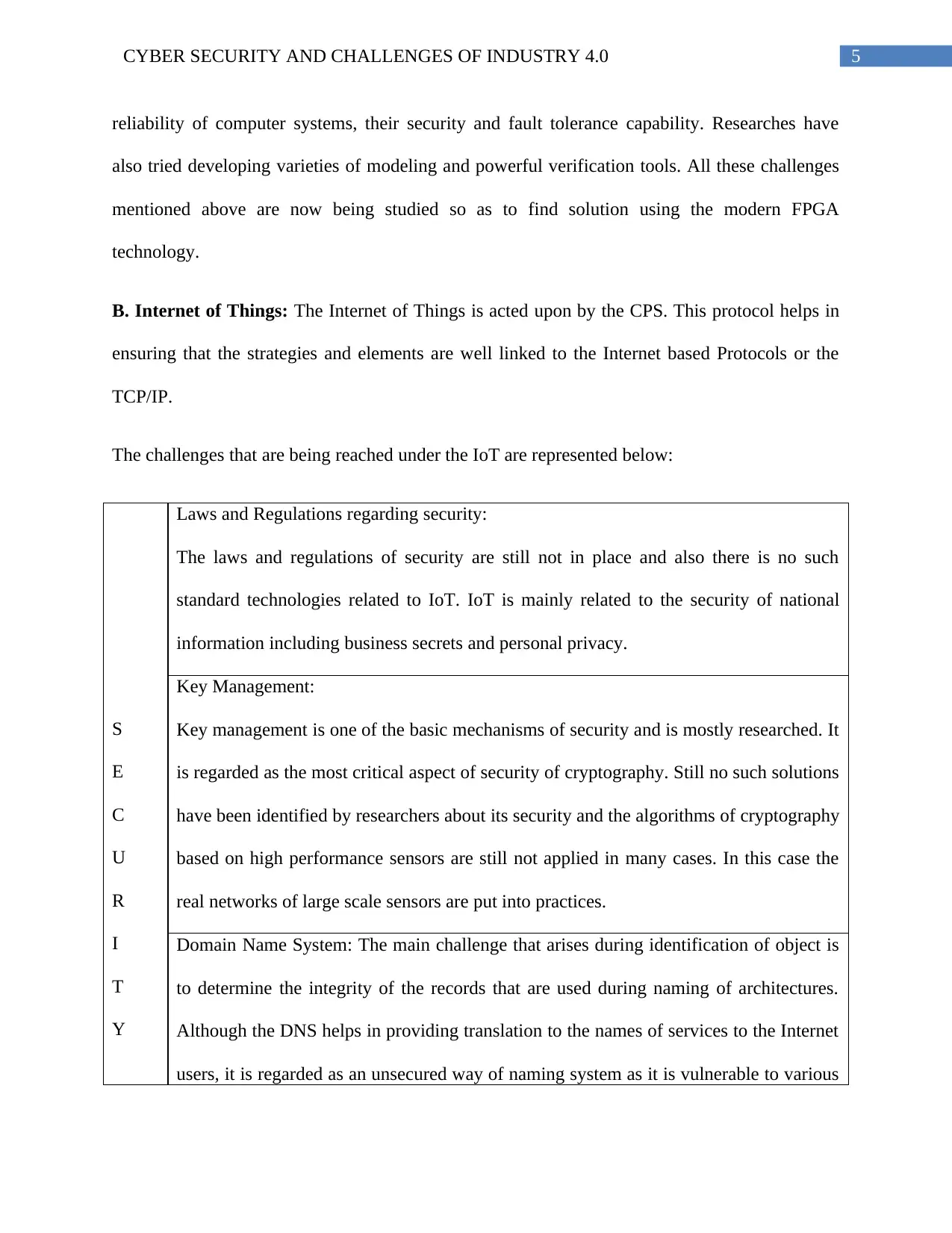
5CYBER SECURITY AND CHALLENGES OF INDUSTRY 4.0
reliability of computer systems, their security and fault tolerance capability. Researches have
also tried developing varieties of modeling and powerful verification tools. All these challenges
mentioned above are now being studied so as to find solution using the modern FPGA
technology.
B. Internet of Things: The Internet of Things is acted upon by the CPS. This protocol helps in
ensuring that the strategies and elements are well linked to the Internet based Protocols or the
TCP/IP.
The challenges that are being reached under the IoT are represented below:
S
E
C
U
R
I
T
Y
Laws and Regulations regarding security:
The laws and regulations of security are still not in place and also there is no such
standard technologies related to IoT. IoT is mainly related to the security of national
information including business secrets and personal privacy.
Key Management:
Key management is one of the basic mechanisms of security and is mostly researched. It
is regarded as the most critical aspect of security of cryptography. Still no such solutions
have been identified by researchers about its security and the algorithms of cryptography
based on high performance sensors are still not applied in many cases. In this case the
real networks of large scale sensors are put into practices.
Domain Name System: The main challenge that arises during identification of object is
to determine the integrity of the records that are used during naming of architectures.
Although the DNS helps in providing translation to the names of services to the Internet
users, it is regarded as an unsecured way of naming system as it is vulnerable to various
reliability of computer systems, their security and fault tolerance capability. Researches have
also tried developing varieties of modeling and powerful verification tools. All these challenges
mentioned above are now being studied so as to find solution using the modern FPGA
technology.
B. Internet of Things: The Internet of Things is acted upon by the CPS. This protocol helps in
ensuring that the strategies and elements are well linked to the Internet based Protocols or the
TCP/IP.
The challenges that are being reached under the IoT are represented below:
S
E
C
U
R
I
T
Y
Laws and Regulations regarding security:
The laws and regulations of security are still not in place and also there is no such
standard technologies related to IoT. IoT is mainly related to the security of national
information including business secrets and personal privacy.
Key Management:
Key management is one of the basic mechanisms of security and is mostly researched. It
is regarded as the most critical aspect of security of cryptography. Still no such solutions
have been identified by researchers about its security and the algorithms of cryptography
based on high performance sensors are still not applied in many cases. In this case the
real networks of large scale sensors are put into practices.
Domain Name System: The main challenge that arises during identification of object is
to determine the integrity of the records that are used during naming of architectures.
Although the DNS helps in providing translation to the names of services to the Internet
users, it is regarded as an unsecured way of naming system as it is vulnerable to various
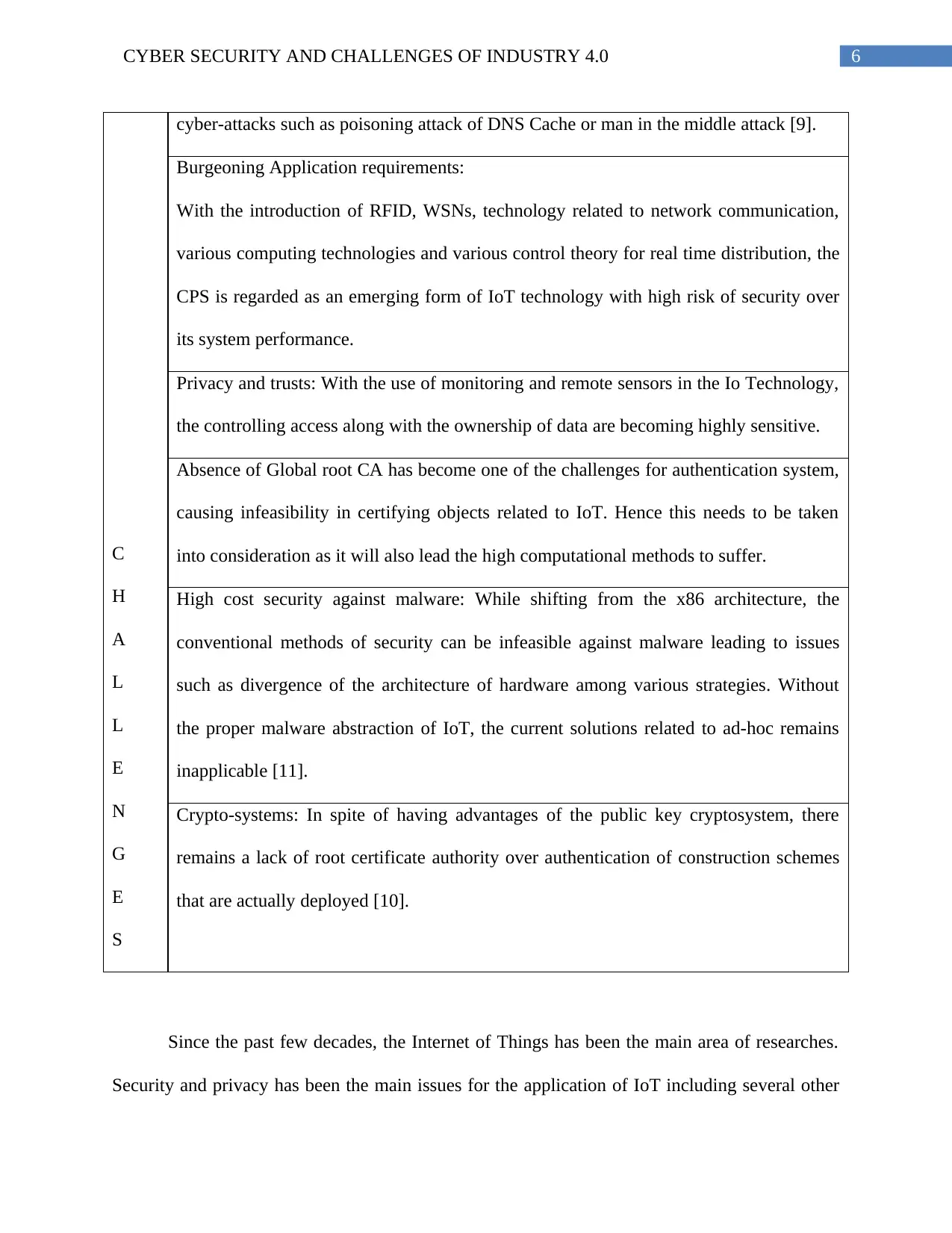
6CYBER SECURITY AND CHALLENGES OF INDUSTRY 4.0
C
H
A
L
L
E
N
G
E
S
cyber-attacks such as poisoning attack of DNS Cache or man in the middle attack [9].
Burgeoning Application requirements:
With the introduction of RFID, WSNs, technology related to network communication,
various computing technologies and various control theory for real time distribution, the
CPS is regarded as an emerging form of IoT technology with high risk of security over
its system performance.
Privacy and trusts: With the use of monitoring and remote sensors in the Io Technology,
the controlling access along with the ownership of data are becoming highly sensitive.
Absence of Global root CA has become one of the challenges for authentication system,
causing infeasibility in certifying objects related to IoT. Hence this needs to be taken
into consideration as it will also lead the high computational methods to suffer.
High cost security against malware: While shifting from the x86 architecture, the
conventional methods of security can be infeasible against malware leading to issues
such as divergence of the architecture of hardware among various strategies. Without
the proper malware abstraction of IoT, the current solutions related to ad-hoc remains
inapplicable [11].
Crypto-systems: In spite of having advantages of the public key cryptosystem, there
remains a lack of root certificate authority over authentication of construction schemes
that are actually deployed [10].
Since the past few decades, the Internet of Things has been the main area of researches.
Security and privacy has been the main issues for the application of IoT including several other
C
H
A
L
L
E
N
G
E
S
cyber-attacks such as poisoning attack of DNS Cache or man in the middle attack [9].
Burgeoning Application requirements:
With the introduction of RFID, WSNs, technology related to network communication,
various computing technologies and various control theory for real time distribution, the
CPS is regarded as an emerging form of IoT technology with high risk of security over
its system performance.
Privacy and trusts: With the use of monitoring and remote sensors in the Io Technology,
the controlling access along with the ownership of data are becoming highly sensitive.
Absence of Global root CA has become one of the challenges for authentication system,
causing infeasibility in certifying objects related to IoT. Hence this needs to be taken
into consideration as it will also lead the high computational methods to suffer.
High cost security against malware: While shifting from the x86 architecture, the
conventional methods of security can be infeasible against malware leading to issues
such as divergence of the architecture of hardware among various strategies. Without
the proper malware abstraction of IoT, the current solutions related to ad-hoc remains
inapplicable [11].
Crypto-systems: In spite of having advantages of the public key cryptosystem, there
remains a lack of root certificate authority over authentication of construction schemes
that are actually deployed [10].
Since the past few decades, the Internet of Things has been the main area of researches.
Security and privacy has been the main issues for the application of IoT including several other
Paraphrase This Document
Need a fresh take? Get an instant paraphrase of this document with our AI Paraphraser
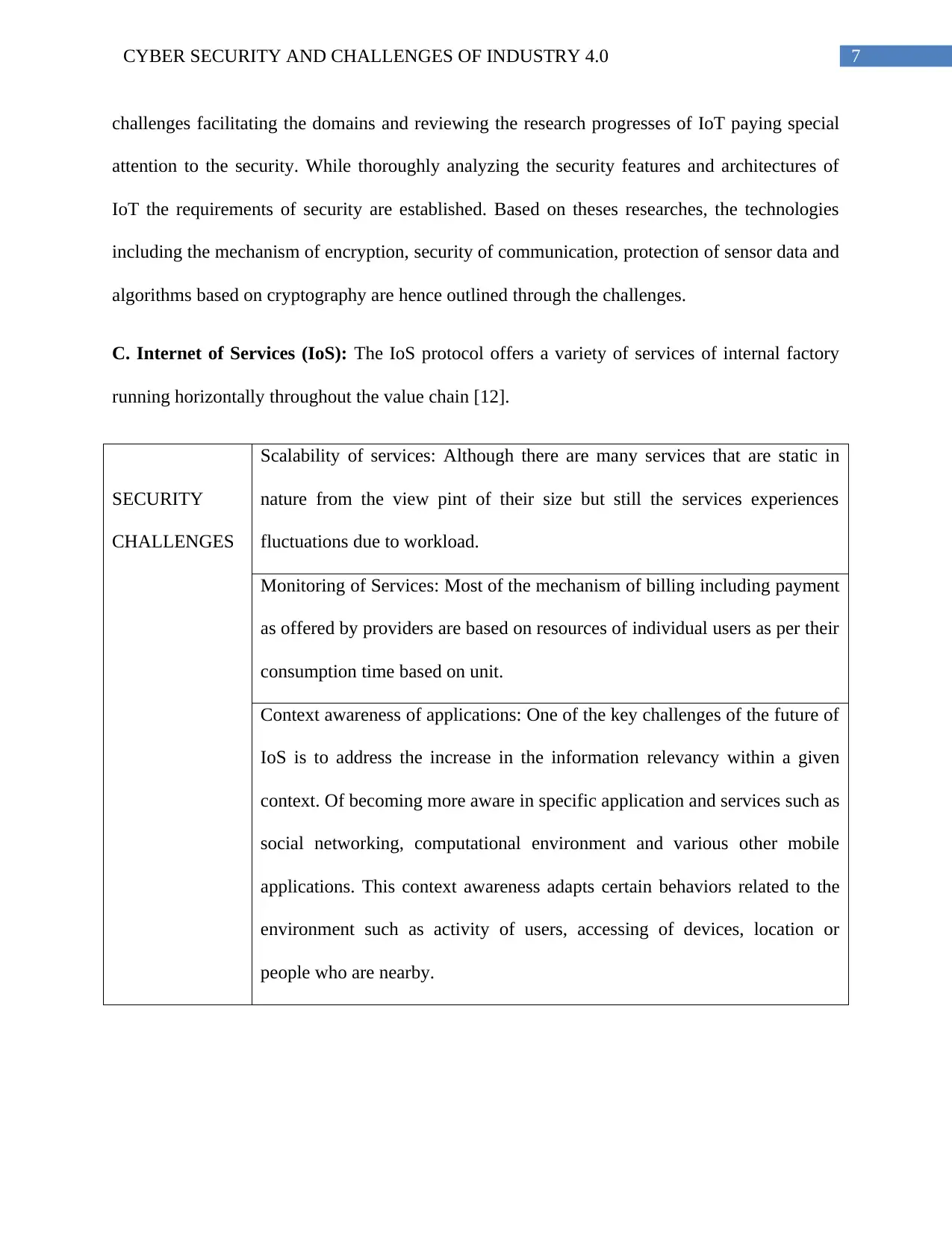
7CYBER SECURITY AND CHALLENGES OF INDUSTRY 4.0
challenges facilitating the domains and reviewing the research progresses of IoT paying special
attention to the security. While thoroughly analyzing the security features and architectures of
IoT the requirements of security are established. Based on theses researches, the technologies
including the mechanism of encryption, security of communication, protection of sensor data and
algorithms based on cryptography are hence outlined through the challenges.
C. Internet of Services (IoS): The IoS protocol offers a variety of services of internal factory
running horizontally throughout the value chain [12].
SECURITY
CHALLENGES
Scalability of services: Although there are many services that are static in
nature from the view pint of their size but still the services experiences
fluctuations due to workload.
Monitoring of Services: Most of the mechanism of billing including payment
as offered by providers are based on resources of individual users as per their
consumption time based on unit.
Context awareness of applications: One of the key challenges of the future of
IoS is to address the increase in the information relevancy within a given
context. Of becoming more aware in specific application and services such as
social networking, computational environment and various other mobile
applications. This context awareness adapts certain behaviors related to the
environment such as activity of users, accessing of devices, location or
people who are nearby.
challenges facilitating the domains and reviewing the research progresses of IoT paying special
attention to the security. While thoroughly analyzing the security features and architectures of
IoT the requirements of security are established. Based on theses researches, the technologies
including the mechanism of encryption, security of communication, protection of sensor data and
algorithms based on cryptography are hence outlined through the challenges.
C. Internet of Services (IoS): The IoS protocol offers a variety of services of internal factory
running horizontally throughout the value chain [12].
SECURITY
CHALLENGES
Scalability of services: Although there are many services that are static in
nature from the view pint of their size but still the services experiences
fluctuations due to workload.
Monitoring of Services: Most of the mechanism of billing including payment
as offered by providers are based on resources of individual users as per their
consumption time based on unit.
Context awareness of applications: One of the key challenges of the future of
IoS is to address the increase in the information relevancy within a given
context. Of becoming more aware in specific application and services such as
social networking, computational environment and various other mobile
applications. This context awareness adapts certain behaviors related to the
environment such as activity of users, accessing of devices, location or
people who are nearby.
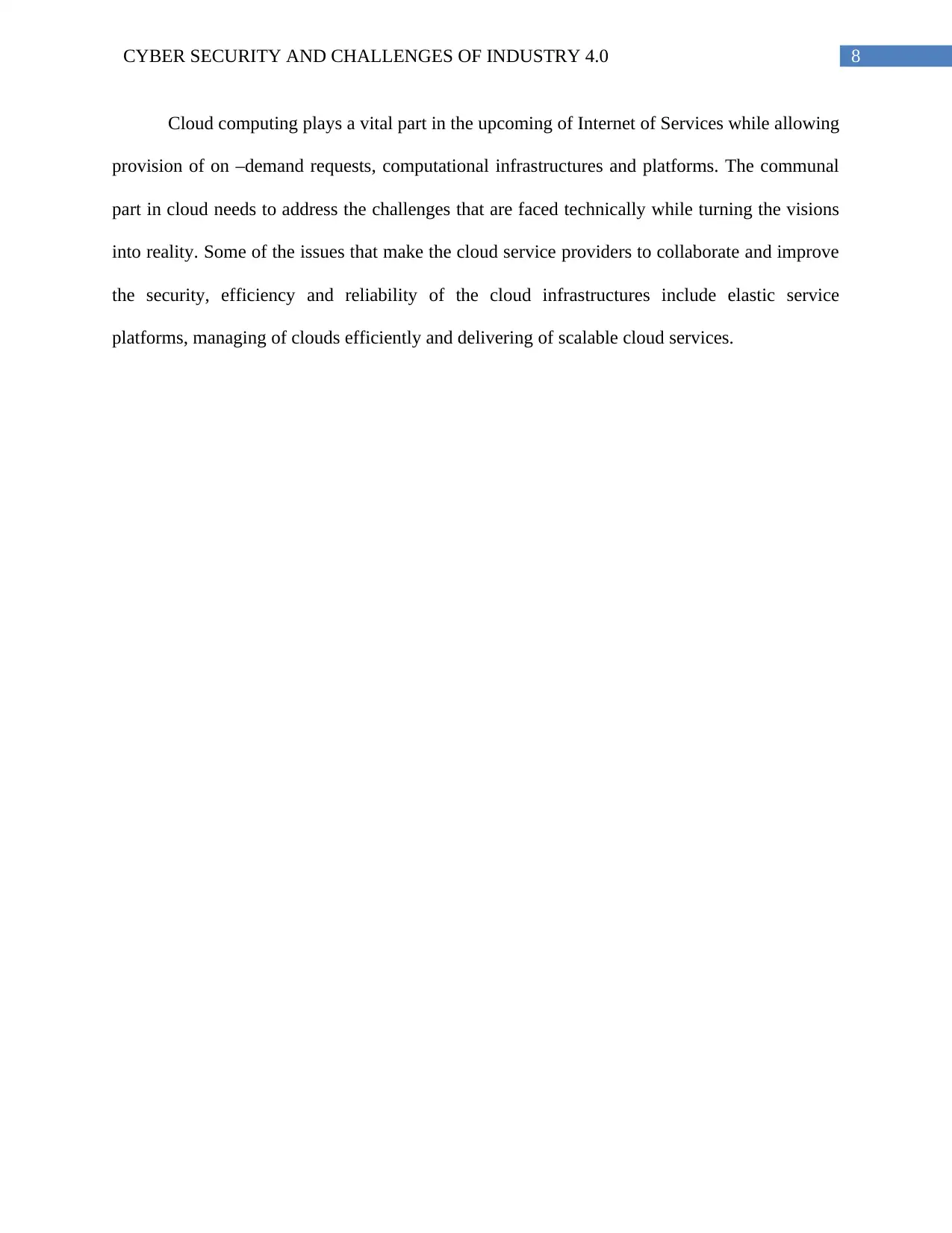
8CYBER SECURITY AND CHALLENGES OF INDUSTRY 4.0
Cloud computing plays a vital part in the upcoming of Internet of Services while allowing
provision of on –demand requests, computational infrastructures and platforms. The communal
part in cloud needs to address the challenges that are faced technically while turning the visions
into reality. Some of the issues that make the cloud service providers to collaborate and improve
the security, efficiency and reliability of the cloud infrastructures include elastic service
platforms, managing of clouds efficiently and delivering of scalable cloud services.
Cloud computing plays a vital part in the upcoming of Internet of Services while allowing
provision of on –demand requests, computational infrastructures and platforms. The communal
part in cloud needs to address the challenges that are faced technically while turning the visions
into reality. Some of the issues that make the cloud service providers to collaborate and improve
the security, efficiency and reliability of the cloud infrastructures include elastic service
platforms, managing of clouds efficiently and delivering of scalable cloud services.
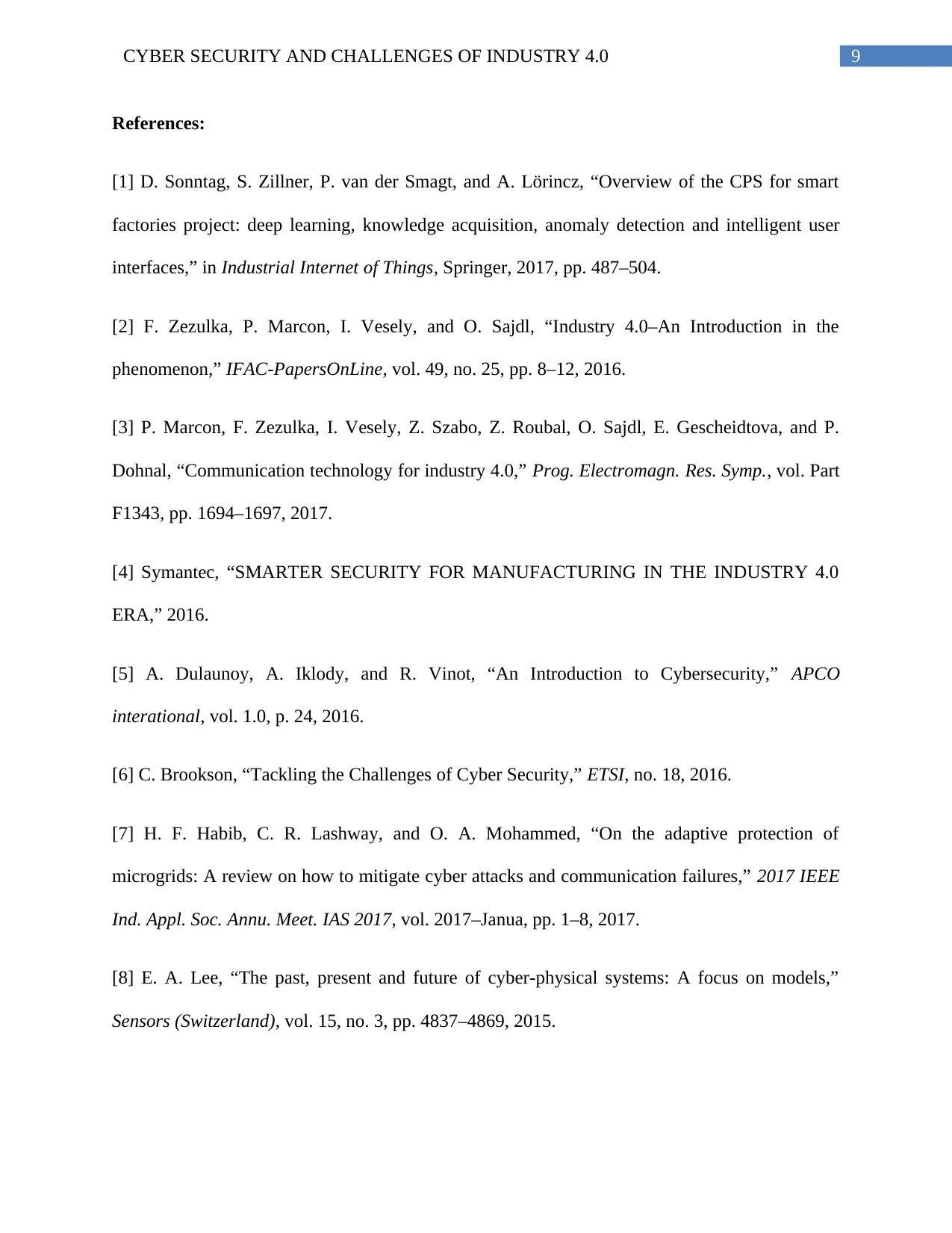
9CYBER SECURITY AND CHALLENGES OF INDUSTRY 4.0
References:
[1] D. Sonntag, S. Zillner, P. van der Smagt, and A. Lörincz, “Overview of the CPS for smart
factories project: deep learning, knowledge acquisition, anomaly detection and intelligent user
interfaces,” in Industrial Internet of Things, Springer, 2017, pp. 487–504.
[2] F. Zezulka, P. Marcon, I. Vesely, and O. Sajdl, “Industry 4.0–An Introduction in the
phenomenon,” IFAC-PapersOnLine, vol. 49, no. 25, pp. 8–12, 2016.
[3] P. Marcon, F. Zezulka, I. Vesely, Z. Szabo, Z. Roubal, O. Sajdl, E. Gescheidtova, and P.
Dohnal, “Communication technology for industry 4.0,” Prog. Electromagn. Res. Symp., vol. Part
F1343, pp. 1694–1697, 2017.
[4] Symantec, “SMARTER SECURITY FOR MANUFACTURING IN THE INDUSTRY 4.0
ERA,” 2016.
[5] A. Dulaunoy, A. Iklody, and R. Vinot, “An Introduction to Cybersecurity,” APCO
interational, vol. 1.0, p. 24, 2016.
[6] C. Brookson, “Tackling the Challenges of Cyber Security,” ETSI, no. 18, 2016.
[7] H. F. Habib, C. R. Lashway, and O. A. Mohammed, “On the adaptive protection of
microgrids: A review on how to mitigate cyber attacks and communication failures,” 2017 IEEE
Ind. Appl. Soc. Annu. Meet. IAS 2017, vol. 2017–Janua, pp. 1–8, 2017.
[8] E. A. Lee, “The past, present and future of cyber-physical systems: A focus on models,”
Sensors (Switzerland), vol. 15, no. 3, pp. 4837–4869, 2015.
References:
[1] D. Sonntag, S. Zillner, P. van der Smagt, and A. Lörincz, “Overview of the CPS for smart
factories project: deep learning, knowledge acquisition, anomaly detection and intelligent user
interfaces,” in Industrial Internet of Things, Springer, 2017, pp. 487–504.
[2] F. Zezulka, P. Marcon, I. Vesely, and O. Sajdl, “Industry 4.0–An Introduction in the
phenomenon,” IFAC-PapersOnLine, vol. 49, no. 25, pp. 8–12, 2016.
[3] P. Marcon, F. Zezulka, I. Vesely, Z. Szabo, Z. Roubal, O. Sajdl, E. Gescheidtova, and P.
Dohnal, “Communication technology for industry 4.0,” Prog. Electromagn. Res. Symp., vol. Part
F1343, pp. 1694–1697, 2017.
[4] Symantec, “SMARTER SECURITY FOR MANUFACTURING IN THE INDUSTRY 4.0
ERA,” 2016.
[5] A. Dulaunoy, A. Iklody, and R. Vinot, “An Introduction to Cybersecurity,” APCO
interational, vol. 1.0, p. 24, 2016.
[6] C. Brookson, “Tackling the Challenges of Cyber Security,” ETSI, no. 18, 2016.
[7] H. F. Habib, C. R. Lashway, and O. A. Mohammed, “On the adaptive protection of
microgrids: A review on how to mitigate cyber attacks and communication failures,” 2017 IEEE
Ind. Appl. Soc. Annu. Meet. IAS 2017, vol. 2017–Janua, pp. 1–8, 2017.
[8] E. A. Lee, “The past, present and future of cyber-physical systems: A focus on models,”
Sensors (Switzerland), vol. 15, no. 3, pp. 4837–4869, 2015.
Secure Best Marks with AI Grader
Need help grading? Try our AI Grader for instant feedback on your assignments.
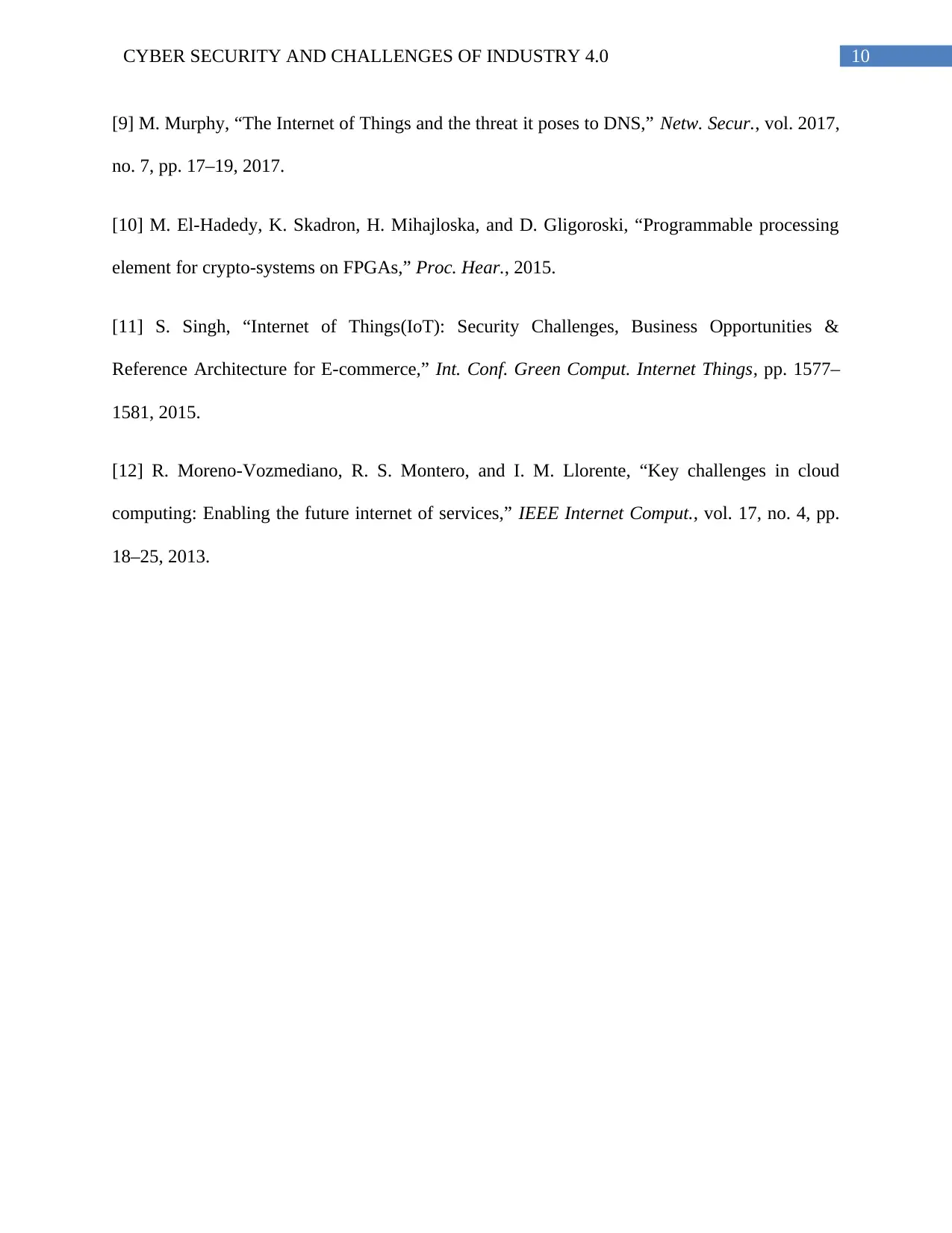
10CYBER SECURITY AND CHALLENGES OF INDUSTRY 4.0
[9] M. Murphy, “The Internet of Things and the threat it poses to DNS,” Netw. Secur., vol. 2017,
no. 7, pp. 17–19, 2017.
[10] M. El-Hadedy, K. Skadron, H. Mihajloska, and D. Gligoroski, “Programmable processing
element for crypto-systems on FPGAs,” Proc. Hear., 2015.
[11] S. Singh, “Internet of Things(IoT): Security Challenges, Business Opportunities &
Reference Architecture for E-commerce,” Int. Conf. Green Comput. Internet Things, pp. 1577–
1581, 2015.
[12] R. Moreno-Vozmediano, R. S. Montero, and I. M. Llorente, “Key challenges in cloud
computing: Enabling the future internet of services,” IEEE Internet Comput., vol. 17, no. 4, pp.
18–25, 2013.
[9] M. Murphy, “The Internet of Things and the threat it poses to DNS,” Netw. Secur., vol. 2017,
no. 7, pp. 17–19, 2017.
[10] M. El-Hadedy, K. Skadron, H. Mihajloska, and D. Gligoroski, “Programmable processing
element for crypto-systems on FPGAs,” Proc. Hear., 2015.
[11] S. Singh, “Internet of Things(IoT): Security Challenges, Business Opportunities &
Reference Architecture for E-commerce,” Int. Conf. Green Comput. Internet Things, pp. 1577–
1581, 2015.
[12] R. Moreno-Vozmediano, R. S. Montero, and I. M. Llorente, “Key challenges in cloud
computing: Enabling the future internet of services,” IEEE Internet Comput., vol. 17, no. 4, pp.
18–25, 2013.
1 out of 11
Related Documents
Your All-in-One AI-Powered Toolkit for Academic Success.
+13062052269
info@desklib.com
Available 24*7 on WhatsApp / Email
![[object Object]](/_next/static/media/star-bottom.7253800d.svg)
Unlock your academic potential
© 2024 | Zucol Services PVT LTD | All rights reserved.





